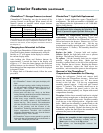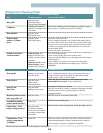
15
the original carton and refrigerate immediately after
purchasing and after each use.
Frozen Food Storage
• The freezer compartment of a refrigerator should be
kept at approximately 0°F. To check the
temperature, place an appliance thermometer
between the frozen packages and check after 24
hours. If the temperature is above 0˚F, adjust the
control as described on page 3.
• A freezer operates more efficiently when it is at least
two-thirds full.
Packaging Foods for Freezing
• To minimize dehydration and quality deterioration,
use aluminum foil, freezer wrap, freezer bags or
airtight containers. Force as much air out of the
packages as possible and be sure they are tightly
sealed. Trapped air can cause the food to dry out,
change color and develop an off-flavor (freezer
burn).
• Overwrap fresh meats and poultry with suitable
freezer wrap prior to freezing.
• Do not refreeze meat that has completely
thawed.
Loading the Freezer
• Avoid adding too much warm food to the freezer at
one time. This overloads the freezer, slows the rate of
freezing and can raise the temperature of frozen
foods.
• Leave space between the packages so cold air can
circulate freely, allowing food to freeze as quickly as
possible.
• Avoid storing hard-to-freeze foods such as ice cream
and orange juice on the freezer door shelves. These
foods are best stored in the freezer interior where
the temperature varies less with door openings.
Fresh Food Storage
• The fresh-food compartment of a refrigerator should
be kept between 34°F and 40°F with an optimum
temperature of 37°F. To check the temperature,
place an appliance thermometer in a glass of water
and place in the center of the refrigerator. Check
after 24 hours. If the temperature is above 40°F,
adjust the controls as explained on page 3.
• Temperatures measured elsewhere in the
refrigerator may vary from crisper readout
temperatures (select models) due to location of
crisper thermostat.
• Avoid overcrowding the refrigerator shelves. This
reduces the circulation of air around the food and
results in uneven cooling.
Fruit and Vegetables
• Store in the crisper drawers to help preserve the fruit
and vegetable quality for longer time periods.
• Sort fruits and vegetables before storage and use
bruised or soft items first. Discard those showing
signs of decay.
• Always wrap odorous foods such as onions and
cabbage so the odor does not transfer to other foods.
• While vegetables need a certain amount of moisture
to remain fresh, too much moisture can shorten
storage times (especially lettuce). Drain vegetables
well before storing.
Meat and Cheese
• Raw meat and poultry should be wrapped securely
so leakage and contamination of other foods or
surfaces does not occur.
• Occasionally mold will develop on the surface of
hard cheeses (Swiss, Cheddar, Parmesan). Cut off at
least an inch around and below the moldy area. Keep
your knife or instrument out of the mold itself. The
remaining cheese will be safe and flavorful to eat. Do
NOT try to save individual cheese slices, soft cheese,
cottage cheese, cream, sour cream or yogurt when
mold appears.
Dairy Food
• Most dairy foods such as milk, yogurt, sour cream and
cottage cheese have freshness dates on their cartons
for appropriate length of storage. Store these foods in
Food Storage Tips


















